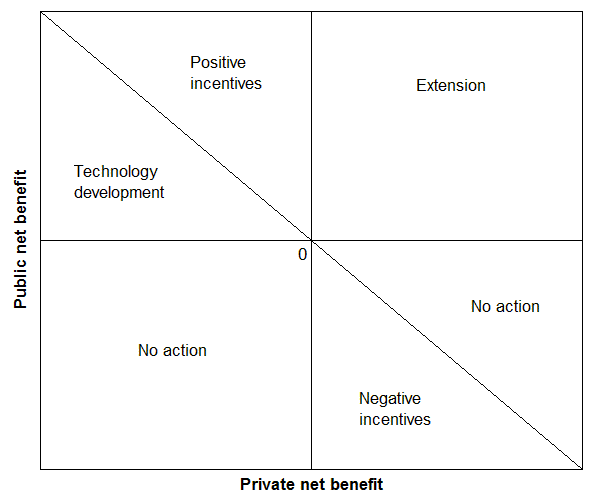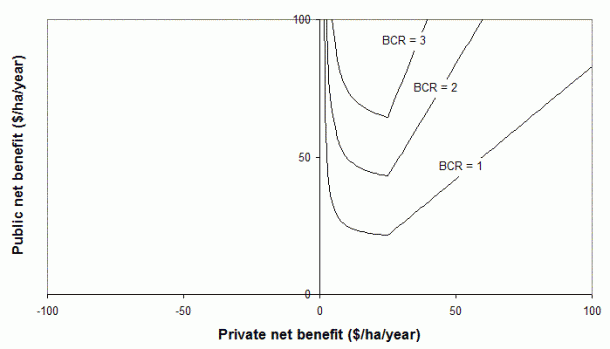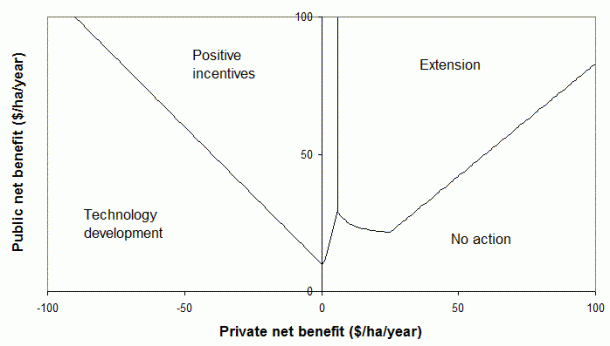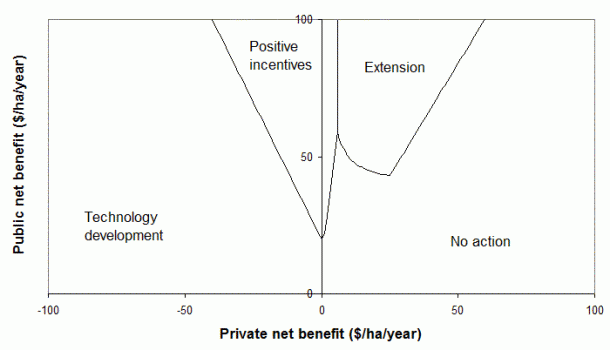76 – Public benefits, private benefits, and extension
This is the fourth instalment of a series that examines a simple framework for choosing environmental policy instruments, as outlined in PD#73. The framework is based on levels of public and private net benefits of changing land management, and a set of simple rules. This time we focus on the use of extension and compare it to positive incentives.
In PD#73 I showed how a set of simple and reasonable rules can lead to a map of efficient policy instruments (Figure 1). The context is an environmental manager considering prospective projects to change land use in particular ways on particular pieces of private land. The map below shows that the choice of instruments depends crucially on the levels of public and private net benefits from those projects. A particular project to change land use in particular ways on particular pieces of land would be represented by a dot somewhere on Figure 1. Depending on where the various dots lie, different types of policy response are recommended.
In PD#74 and PD#75 we focused on the use of positive incentives. This time we examine extension more closely.
Figure 1. Efficient policy mechanisms for encouraging land use on private land.
Extension (e.g. education, technology transfer, communications generally) is a relatively cheap policy instrument that helps landholders to learn about the available land management practices, including practices that environmental managers would like to see adopted. (By “cheap” I mean cheap per hectare of adoption that it generates, when used in appropriate circumstances, relative to, say, payment of financial incentives.)
Only for projects that fall in the top-right area is extension likely to accelerate adoption of the land practices with high public benefits (e.g. environmental benefits). We know that those are the practices with positive public benefits because they are in the top half of the graph. Extension can work to generate adoption for these projects because the private net benefits of adoption are positive – they are on the right side of the graph – and extension could help landholders to realise this. Extension alone could not generate sustained adoption for projects in say the Technology development area because, from the perspective of private landholders, those projects generate costs larger than the benefits.
In the simple framework of PD#73, we didn’t consider the fact that, even though private net benefits from land-use change are positive in the top-right area, there may still be costs and impediments to learning that must be overcome. We also did not discuss the effect that extension can have on the lags to adoption. In reality, extension may shorten, but will probably not eliminate, the lags.
In PD#75 we argued that adoption lags (in the absence of extension or incentives) would be related to the level of private net benefits, with longer lags for practices with lower private net benefits. If we use the illustrative adoption curve from PD#75, and make some other assumptions, then we can map the area where extension will generate sufficient public benefits to offset the costs of the extension – where the benefit:cost ratio (BCR) from extension is at least 1. For the purpose of this discussion, I will assume that (a) extension reduces the adoption lag for any project by two years, (b) the real discount rate is 5%, (c) extension costs about $2/ha/year (20% of the assumed learning costs associated with land-use change, expressed in annualised form). Given those assumptions, extension could pay off anywhere above the BCR =1 line in Figure 2.
Figure 2. Benefit:cost ratios from use of extension, allowing for adoption lags and learning costs
It is not worth paying for extension if the public net benefits are too low (below about $25/ha/year in this example).
If we require higher BCRs from our investment in extension, we need to select projects that will generate higher public net benefits, and also higher private net benefits, up to a point (the point where the lag without extension is shorter than the benefit of extension). As we move further to the right side of the graph, increasing the private net benefits starts to reduce the net benefits of extension, because landholders are more inclined to adopt the new practices even without extension.
Figure 2 above can be combined with the comparable graph for incentives (Figure 3 in PD#75) to generate a new map of where positive incentives or extension would be preferred (Figure 3, below). This is a modified version of the original map in Figure 1, allowing for the additional complexities we have now built in.
Figure 3. Revised map of efficient policy mechanisms allowing for adoption lags and learning costs.
The differences between Figure 1 and Figure 3 are:
• Public benefits need to be a little higher to justify positive incentives, so we would be slightly more likely to fall back on technology development;
• Extension is not worthwhile if public net benefits are not sufficiently high, and is replaced (or perhaps supplemented) by positive incentives if there are low private net benefits.
Realistically, a BCR of 1 is not sufficient to offset program fixed costs. Figure 4 shows a version of the map if we require a higher benefit:cost ratio of 2.0 to justify positive incentives or extension. The effect is to require higher public net benefits to justify the selection of projects.
Figure 4. Revised map of efficient policy mechanisms allowing for adoption lags and learning costs, if positive incentives and extension require BCR = 2.
This figure helps to identify how environmental programs should target their efforts to achieve high payoffs. It indicates that projects are more likely to generate high payoffs to investment in positive incentives or extension if the private net benefits are closer to zero. For those projects with net private benefits that are not too different from zero, land-use change can be prompted with modest incentives, or extension can accelerate the adoption of practices that would not otherwise be adopted quickly.
It is notable that the targeting of investment depends at least as much on the level of private net benefits as on public net benefits. Indeed, the choice of high BCR projects is even more sensitive to private than to public benefits.
David Pannell, The University of Western Australia



